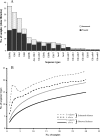Seasonal dynamics of arbuscular mycorrhizal fungal communities in roots in a seminatural grassland
- PMID: 17630308
- PMCID: PMC2042099
- DOI: 10.1128/AEM.00262-07
Seasonal dynamics of arbuscular mycorrhizal fungal communities in roots in a seminatural grassland
Abstract
Symbiotic arbuscular mycorrhizal fungi (AMF) have been shown to influence both the diversity and productivity of grassland plant communities. These effects have been postulated to depend on the differential effects of individual mycorrhizal taxa on different plant species; however, so far there are few detailed studies of the dynamics of AMF colonization of different plant species. In this study, we characterized the communities of AMF colonizing the roots of two plant species, Prunella vulgaris and Antennaria dioica, in a Swedish seminatural grassland at different times of the year. The AMF small subunit rRNA genes were subjected to PCR, cloning, sequencing, and phylogenetic analysis. Nineteen discrete sequence types belonging to Glomus groups A and B and to the genus Acaulospora were distinguished. No significant seasonal changes in the species compositions of the AMF communities as a whole were observed. However, the two plant species hosted significantly different AMF communities. P. vulgaris hosted a rich AMF community throughout the entire growing season. The presence of AMF in A. dioica decreased dramatically in autumn, while an increased presence of Ascomycetes species was detected.
Figures





References
-
- Addy, H. D., M. M. Piercey, and R. S. Currah. 2005. Microfungal endophytes in roots. Can. J. Bot. 83:1-13.
-
- Bever, J. D., P. A. Schultz, A. Pringle, and J. B. Morton. 2001. Arbuscular mycorrhizal fungi: more diverse than meets the eye, and the ecological tale of why. Bioscience 51:923-931.
-
- Bianciotto, V., and P. Bonfante. 1992. Quantification of the nuclear DNA content of two arbuscular mycorrhizal fungi. Mycol. Res. 96:1071-1076.
-
- Borowicz, V. A. 2001. Do arbuscular mycorrhizal fungi alter plant-pathogen relations? Ecology 82:3057-3068.
Publication types
MeSH terms
Substances
Associated data
- Actions
- Actions
- Actions
- Actions
- Actions
- Actions
- Actions
- Actions
- Actions
- Actions
- Actions
- Actions
- Actions
- Actions
- Actions
- Actions
- Actions
- Actions
- Actions
- Actions
- Actions
- Actions
- Actions
- Actions
- Actions
- Actions
- Actions
- Actions
- Actions
- Actions
- Actions
- Actions
- Actions
- Actions
- Actions
- Actions
- Actions
- Actions
- Actions
- Actions
- Actions
- Actions
- Actions
- Actions
- Actions
- Actions
- Actions
- Actions
- Actions
- Actions
- Actions
- Actions
- Actions
- Actions
- Actions
- Actions
- Actions
- Actions
- Actions
- Actions
- Actions
- Actions
- Actions
- Actions
- Actions
- Actions
- Actions
- Actions
- Actions
- Actions
- Actions
- Actions
- Actions
- Actions
- Actions
- Actions
- Actions
- Actions
- Actions
- Actions
- Actions
- Actions
- Actions
- Actions
- Actions
- Actions
- Actions
- Actions
- Actions
- Actions
- Actions
- Actions
- Actions
- Actions
- Actions
- Actions
- Actions
- Actions
- Actions
- Actions
- Actions
- Actions
- Actions
- Actions
- Actions
- Actions
- Actions
- Actions
- Actions
- Actions
- Actions
- Actions
- Actions
- Actions
- Actions
- Actions
- Actions
- Actions
- Actions
- Actions
- Actions
- Actions
- Actions
- Actions
- Actions
- Actions
- Actions
- Actions
- Actions
- Actions
- Actions
- Actions
- Actions
- Actions
- Actions
- Actions
- Actions
- Actions
- Actions
- Actions
- Actions
- Actions
- Actions
- Actions
- Actions
- Actions
- Actions
- Actions
- Actions
- Actions
- Actions
- Actions
- Actions
- Actions
- Actions
- Actions
- Actions
- Actions
- Actions
- Actions
- Actions
- Actions
- Actions
- Actions
- Actions
- Actions
- Actions
- Actions
- Actions
- Actions
- Actions
- Actions
- Actions
- Actions
- Actions
- Actions
- Actions
- Actions
- Actions
- Actions
- Actions
- Actions
- Actions
- Actions
- Actions
- Actions
- Actions
- Actions
- Actions
- Actions
- Actions
- Actions
- Actions
- Actions
- Actions
- Actions
- Actions
- Actions
- Actions
- Actions
- Actions
- Actions
- Actions
- Actions
- Actions
- Actions
- Actions
- Actions
- Actions
- Actions
- Actions
- Actions
- Actions
- Actions
- Actions
- Actions
- Actions
- Actions
- Actions
- Actions
- Actions
- Actions
- Actions
- Actions
- Actions
- Actions
- Actions
- Actions
- Actions
- Actions
- Actions
- Actions
- Actions
- Actions
- Actions
- Actions
- Actions
- Actions
- Actions
- Actions
- Actions
- Actions
- Actions
- Actions
- Actions
- Actions
- Actions
LinkOut - more resources
Full Text Sources
Medical

